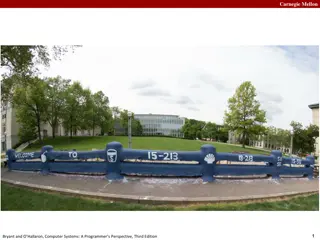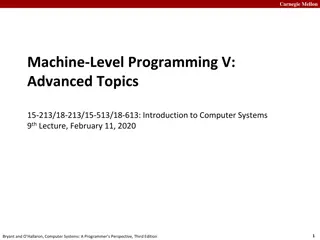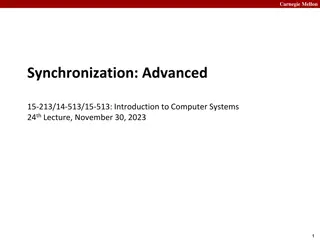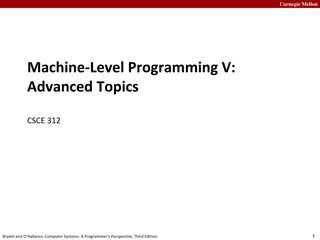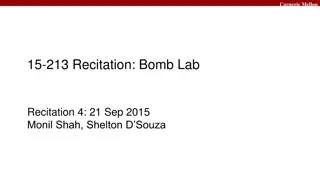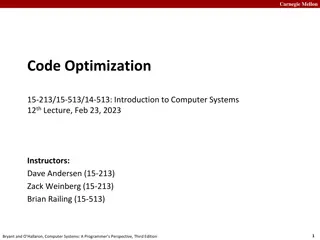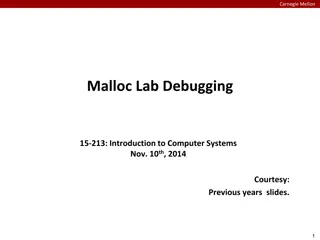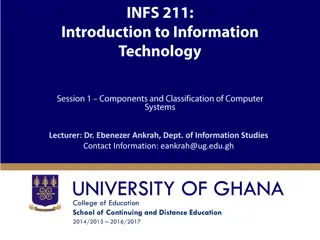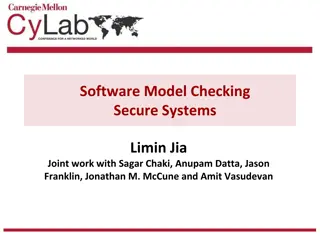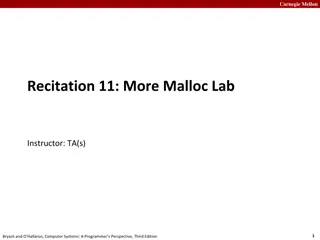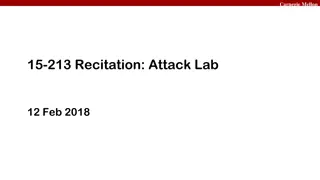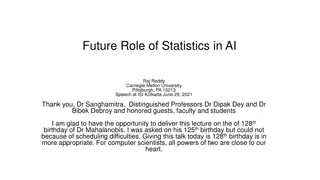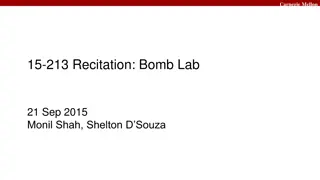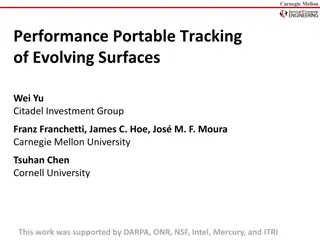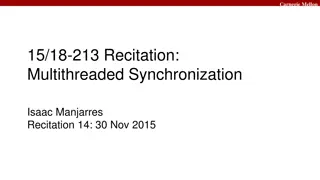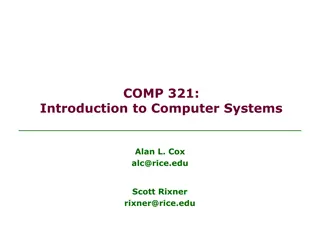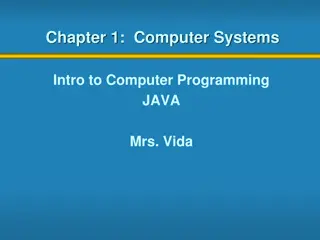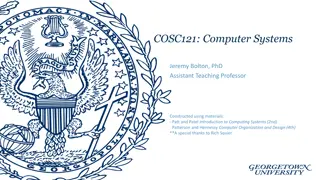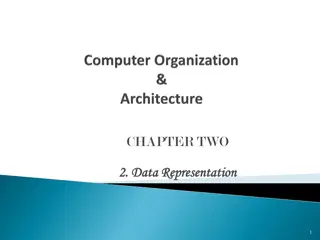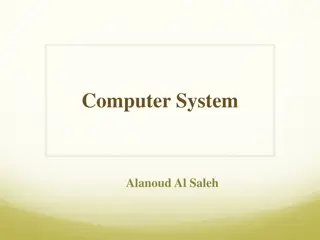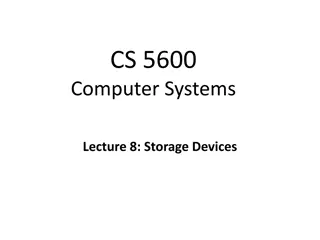Exploring Carnegie Mellon's Introduction to Computer Systems
Delve into the world of computer systems with Carnegie Mellon University's System-Level I/O course, covering concepts such as file operations, Unix I/O, and kernel data structures. Learn about standard I/O, handling I/O devices as files, and understanding the sequence of bytes in a file. Discover the intersection of high-level convenience and low-level control in system programming.
Download Presentation

Please find below an Image/Link to download the presentation.
The content on the website is provided AS IS for your information and personal use only. It may not be sold, licensed, or shared on other websites without obtaining consent from the author. Download presentation by click this link. If you encounter any issues during the download, it is possible that the publisher has removed the file from their server.
E N D
Presentation Transcript
Carnegie Mellon System-Level I/O 15-213/14-513/15-513: Introduction to Computer Systems 20thLecture, November 10, 2022 Instructors: Dave Andersen (15-213) Zack Weinberg (15-213) Brian Railing (15-513) David Varodayan (14-513) 1 Bryant and O Hallaron, Computer Systems: A Programmer s Perspective, Third Edition
Carnegie Mellon System level: below standard level FILE *fopen(const char *fname, const char *mode) { int fd = open(fname, #include <stdio.h> __mode2flags(mode), DEFFILEPERMS); int main(void) { FILE *fp = fopen("output.txt", "w"); if (!fp) { perror("output.txt"); return 1; } fputs("baby shark (do doo dooo)\n", fp); if (fclose(fp)) { perror("output.txt"); return 1; } return 0; } if (fd == -1) { return NULL; } return fdopen(fd, mode); } int fputs(const char *s, FILE *fp) { size_t n = strlen(s); while (n > 0) { ssize_t written = write(fp->fd, s, n); if (written < 0) return EOF; n -= written; s += written; } return 0; } .globl close close: mov $3, %eax syscall cmp $-4096, %rax jae __syscall_error ret int fclose(FILE *fp) { int rv = close(fp->fd); __ffree(fp); return rv; } 2 Bryant and O Hallaron, Computer Systems: A Programmer s Perspective, Third Edition
Carnegie Mellon Why do we have two sets? fopen fdopen rio_readinitb open fread fscanf fgets fgetc rio_readn rio_readlineb rio_readnb read fwrite fprintf fputs fputc fflush rio_writen write You can write your own set of high- level convenient functions if you want! fseek ftell lseek close fclose Less control More convenience Not safe in signal handlers Not safe with network connections Maximum control Minimum convenience Can be used from signal handlers Can be used for network connections stat 3 Bryant and O Hallaron, Computer Systems: A Programmer s Perspective, Third Edition
Carnegie Mellon Today Unix I/O Standard I/O Which I/O when Metadata, sharing, and redirection 4 Bryant and O Hallaron, Computer Systems: A Programmer s Perspective, Third Edition
Carnegie Mellon Unix I/O Overview A file is a sequence of bytes: B0 , B1 , .... , Bk, .... , Bm-1 Cool fact: All I/O devices are represented as files: /dev/sda2 (disk partition) /dev/tty2 (terminal) /dev/null (discard all writes / read empty file) Cool fact: Kernel data structures are exposed as files cat /proc/$$/status ls -l /proc/$$/fd/ ls RC /sys/devices | less 5 Bryant and O Hallaron, Computer Systems: A Programmer s Perspective, Third Edition
Carnegie Mellon Unix I/O Overview Kernel offers a set of basic operations for all files Opening and closing files open()and close() Reading and writing a file read() and write() Look up information about a file (size, type, last modification time, ) stat(), lstat(), fstat() Changing the current file position (seek) indicates next offset into file to read or write lseek() Bk B0 B1 Bk-1 Bk+1 Current file position = k (in between bytes k-1 and k) 6 Bryant and O Hallaron, Computer Systems: A Programmer s Perspective, Third Edition
Carnegie Mellon File Types Each file has a type indicating its role in the system Regular file: Stores arbitrary data Directory: Index for a related group of files Socket: For communicating with a process on another machine Other file types beyond our scope Named pipes (FIFOs) Symbolic links Character and block devices 7 Bryant and O Hallaron, Computer Systems: A Programmer s Perspective, Third Edition
Carnegie Mellon Regular Files A regular file contains arbitrary data Applications often distinguish between text and binary files Text files contain human-readable text Binary files are everything else (object files, JPEG images, ) Kernel doesn t care! It s all just bytes! Text file is sequence of text lines Text line is sequence of characters terminated (not separated!) by end of line indicator Characters are defined by a text encoding (ASCII, UTF-8, EUC-JP, ) End of line (EOL) indicators: All Unix : Single byte 0x0A line feed (LF) DOS, Windows: Two bytes 0x0D 0x0A Carriage return (CR) followed by line feed (LF) Also used by many Internet protocols C library translates to '\n' 8 Bryant and O Hallaron, Computer Systems: A Programmer s Perspective, Third Edition
Carnegie Mellon Directories Directory consists of an array of entries (also called links) Each entry maps a filename to a file Each directory contains at least two entries . (dot) maps to the directory itself .. (dot dot) maps to the parent directory in the directory hierarchy (next slide) Commands for manipulating directories mkdir: create empty directory ls: view directory contents rmdir: delete empty directory 9 Bryant and O Hallaron, Computer Systems: A Programmer s Perspective, Third Edition
Carnegie Mellon Directory Hierarchy All files are organized as a hierarchy anchored by root directory named / (slash) / bin/ dev/ etc/ home/ usr/ bash tty1 group passwd droh/ bryant/ include/ bin/ hello.c stdio.h sys/ vim unistd.h Kernel maintains current working directory (cwd) for each process Modified using the cd command 10 Bryant and O Hallaron, Computer Systems: A Programmer s Perspective, Third Edition
Carnegie Mellon Pathnames Locations of files in the hierarchy denoted by pathnames Absolute pathname starts with / and denotes path from root /home/droh/hello.c Relative pathname denotes path from current working directory ../droh/hello.c cwd: /home/bryant / bin/ dev/ etc/ home/ usr/ bash tty1 group passwd droh/ bryant/ include/ bin/ hello.c stdio.h sys/ vim unistd.h 11 Bryant and O Hallaron, Computer Systems: A Programmer s Perspective, Third Edition
Carnegie Mellon Opening Files Opening a file informs the kernel that you are getting ready to access that file int fd; /* file descriptor */ if ((fd = open("/etc/hosts", O_RDONLY)) < 0) { perror("open"); exit(1); } Returns a small identifying integer file descriptor fd == -1 indicates that an error occurred Each process begins life with three open files 0: standard input (stdin) 1: standard output (stdout) 2: standard error (stderr) These could be files, pipes, your terminal, or even a network connection! 12 Bryant and O Hallaron, Computer Systems: A Programmer s Perspective, Third Edition
Carnegie Mellon Lots of ways to call open Open an existing file: open(path, flags) Open or create a file: open(path, flags, mode) flags must include exactly one of: Only want to read from file flags must include Create the file if it doesn t exist O_RDONLY O_CREAT Only want to write to file and exactly one of: O_WRONLY Want to do both Only want to write to file O_RDWR O_WRONLY Want to write and read O_RDWR Flags may also include (use | to combine) and maybe also some of: All writes go to the very end O_APPEND Fail if file does exist O_EXCL Delete existing contents if any O_TRUNC All writes go to the very end O_APPEND Close this file if execve() is called O_CLOEXEC Delete existing contents if any O_TRUNC Close this file if execve() is called O_CLOEXEC (and many more consult the open() manpage) 13 Bryant and O Hallaron, Computer Systems: A Programmer s Perspective, Third Edition
Carnegie Mellon The third argument to open Yes, open takes either two or three arguments Bet you thought you couldn t do that in C Look through /usr/include/fcntl.h and try to figure out how it s done Third argument must be present when O_CREAT appears in second argument; ignored otherwise Third argument gives default access permissions for newly created files Modified by umask setting (see man umask) Use DEFFILEMODE (from sys/stat.h) unless you have a specific reason to want something else More explanation: https://linuxfoundation.org/blog/classic-sysadmin-understanding-linux- file-permissions/ https://linuxcommand.org/lc3_lts0090.php https://devconnected.com/linux-file-permissions-complete-guide/ 14 Bryant and O Hallaron, Computer Systems: A Programmer s Perspective, Third Edition
Carnegie Mellon Closing Files Closing a file informs the kernel that you are finished accessing that file if (close(fd) < 0) { fprintf(stderr, "%s: write error: %s", filename, strerror(errno)); exit(1); } Take care not to close any file more than once Same as not calling free() twice on the same pointer Closing a file can fail! Well, not exactly fail the file is still closed The OS is taking this opportunity to report a delayed error from a previous write operation You might silently lose data if you don t check! 15 Bryant and O Hallaron, Computer Systems: A Programmer s Perspective, Third Edition
Carnegie Mellon Reading Files Reading a file copies bytes from the current file position to memory, and then updates file position char buf[512]; int fd; /* file descriptor */ int nbytes; /* number of bytes read */ /* Open file fd ... */ /* Then read up to 512 bytes from file fd */ if ((nbytes = read(fd, buf, sizeof(buf))) < 0) { perror("read"); exit(1); } Returns number of bytes read from file fd into buf Return type ssize_t is signed integer nbytes < 0 indicates that an error occurred Short counts (nbytes < sizeof(buf)) are possible and are not errors! 16 Bryant and O Hallaron, Computer Systems: A Programmer s Perspective, Third Edition
Carnegie Mellon Writing Files Writing a file copies bytes from memory to the current file position, and then updates current file position char buf[512]; int fd; /* file descriptor */ int nbytes; /* number of bytes read */ /* Open the file fd ... */ /* Then write up to 512 bytes from buf to file fd */ if ((nbytes = write(fd, buf, sizeof(buf)) < 0) { perror("write"); exit(1); } Returns number of bytes written from buf to file fd nbytes < 0 indicates that an error occurred As with reads, short counts are possible and are not errors! 17 Bryant and O Hallaron, Computer Systems: A Programmer s Perspective, Third Edition
Carnegie Mellon Simple Unix I/O example Copying stdin to stdout, one byte at a time #include <unistd.h> int main(void) { char c; while(read(STDIN_FILENO, &c, 1) != 0) write(STDOUT_FILENO, &c, 1); return 0; } Always check return codes from system calls! 18 Bryant and O Hallaron, Computer Systems: A Programmer s Perspective, Third Edition
Carnegie Mellon Simple Unix I/O example Copying stdin to stdout, one byte at a time #include <unistd.h> #include <stdio.h> int main(void) { char c; for (;;) { ssize_t nread = read(STDIN_FILENO, &c, 1); if (nread == 0) { return 0; } else if (nread < 0) { perror("stdin"); return 1; } if (write(STDOUT_FILENO, &c, 1) < 1) { perror("stdout: write error"); return 1; } } } 19 Bryant and O Hallaron, Computer Systems: A Programmer s Perspective, Third Edition
Carnegie Mellon Simple Unix I/O example Copying stdin to stdout, one byte at a time #include "csapp.h" int main(void) { char c; while (Read(STDIN_FILENO, &c, 1) != 0) { Write(STDOUT_FILENO, &c, 1); } return 0; } Stevens wrappers make things shorter but they don t let you recover from errors 20 Bryant and O Hallaron, Computer Systems: A Programmer s Perspective, Third Edition
Carnegie Mellon On Short Counts Short counts can occur in these situations: Encountering (end-of-file) EOF on reads Reading text lines from a terminal Reading and writing network sockets, pipes, etc. Short counts never occur in these situations: Reading from disk files (except for EOF) Writing to disk files Best practice is to always allow for short counts. 21 Bryant and O Hallaron, Computer Systems: A Programmer s Perspective, Third Edition
Carnegie Mellon Do activity 1 now ( Unix I/O section) http://www.cs.cmu.edu/~213/activities/system-io.pdf http://www.cs.cmu.edu/~213/activities/system-io.tar 22 Bryant and O Hallaron, Computer Systems: A Programmer s Perspective, Third Edition
Carnegie Mellon Today Unix I/O Standard I/O Which I/O when Metadata, sharing, and redirection 23 Bryant and O Hallaron, Computer Systems: A Programmer s Perspective, Third Edition
Carnegie Mellon Standard I/O Functions The C standard library (libc.so) contains a collection of higher-level standard I/O functions Documented in Appendix B of K&R Examples of standard I/O functions: Opening and closing files (fopen and fclose) Reading and writing bytes (fread and fwrite) Reading and writing text lines (fgets and fputs) Formatted reading and writing (fscanf and fprintf) 24 Bryant and O Hallaron, Computer Systems: A Programmer s Perspective, Third Edition
Carnegie Mellon Standard I/O Streams Standard I/O models open files as streams Abstraction for a file descriptor and a buffer in memory C programs begin life with three open streams (defined in stdio.h) stdin (standard input) stdout (standard output) stderr (standard error) #include <stdio.h> extern FILE *stdin; /* standard input (descriptor 0) */ extern FILE *stdout; /* standard output (descriptor 1) */ extern FILE *stderr; /* standard error (descriptor 2) */ int main() { fprintf(stdout, "Hello, world\n"); } 25 Bryant and O Hallaron, Computer Systems: A Programmer s Perspective, Third Edition
Carnegie Mellon Buffered I/O: Motivation Applications often read/write one character at a time getc, putc, ungetc gets, fgets Read line of text one character at a time, stopping at newline Implementing as Unix I/O calls expensive read and write require Unix kernel calls > 10,000 clock cycles Solution: Buffered read Use Unix read to grab block of bytes User input functions take one byte at a time from buffer Refill buffer when empty already read unread Buffer 26 Bryant and O Hallaron, Computer Systems: A Programmer s Perspective, Third Edition
Carnegie Mellon Buffering in Standard I/O Standard I/O functions use buffered I/O printf("h"); printf("e"); printf("l"); printf("l"); printf("o"); printf("\n"); buf h e l l o \n . . fflush(stdout); write(1, buf, 6); Buffer flushed to output fd on \n , call to fflush or exit, or return from main. 27 Bryant and O Hallaron, Computer Systems: A Programmer s Perspective, Third Edition
Carnegie Mellon Standard I/O Buffering in Action You can see this buffering in action for yourself, using the always fascinating Linux strace program: #include <stdio.h> linux> strace ./hello execve("./hello", ["hello"], [/* ... */]). ... write(1, "hello\n", 6) = 6 ... exit_group(0) = ? int main() { printf("h"); printf("e"); printf("l"); printf("l"); printf("o"); printf("\n"); fflush(stdout); exit(0); } 28 Bryant and O Hallaron, Computer Systems: A Programmer s Perspective, Third Edition
Carnegie Mellon Do activity 2 now ( Standard I/O and Buffering and Performance ) 29 Bryant and O Hallaron, Computer Systems: A Programmer s Perspective, Third Edition
Carnegie Mellon Today Unix I/O Standard I/O Which I/O when Metadata, sharing, and redirection 30 Bryant and O Hallaron, Computer Systems: A Programmer s Perspective, Third Edition
Carnegie Mellon Pros and Cons of Unix I/O Pros Unix I/O is the most general form of I/O All other I/O packages are implemented using Unix I/O functions Unix I/O provides functions for accessing file metadata Unix I/O functions are async-signal-safe and can be used safely in signal handlers Cons Dealing with short counts is tricky and error prone Efficient reading of text lines requires some form of buffering, also tricky and error prone 31 Bryant and O Hallaron, Computer Systems: A Programmer s Perspective, Third Edition
Carnegie Mellon Pros and Cons of Standard I/O Pros: Buffering increases efficiency by decreasing the number of read and write system calls Short counts are handled automatically Cons: Provides no function for accessing file metadata Standard I/O functions are not async-signal-safe, and not appropriate for signal handlers Standard I/O is not appropriate for input and output on network sockets There are poorly documented restrictions on streams that interact badly with restrictions on sockets (CS:APP3e, Sec 10.11) 32 Bryant and O Hallaron, Computer Systems: A Programmer s Perspective, Third Edition
Carnegie Mellon Choosing I/O Functions General rule: use the highest-level I/O functions you can Many C programmers are able to do all of their work using the standard I/O functions But, be sure to understand the functions you use! When to use standard I/O When working with ordinary files When to use raw Unix I/O Inside signal handlers, because Unix I/O is async-signal-safe When you are reading and writing network sockets Libraries dedicated to buffered network I/O make this easier CS:APP rio_* functions; libevent, libuv, In rare cases when you need absolute highest performance 33 Bryant and O Hallaron, Computer Systems: A Programmer s Perspective, Third Edition
Carnegie Mellon Aside: Working with Binary Files Functions you should never use on binary files Text-oriented I/O: such as fgets, scanf, rio_readlineb Interpret EOL characters. Use functions like rio_readn or rio_readnb instead String functions strlen, strcpy, strcat Interprets byte value 0 (end of string) as special 34 Bryant and O Hallaron, Computer Systems: A Programmer s Perspective, Third Edition
Carnegie Mellon Today Unix I/O Standard I/O Which I/O when Metadata, sharing, and redirection 35 Bryant and O Hallaron, Computer Systems: A Programmer s Perspective, Third Edition
Carnegie Mellon File Metadata Metadata is data about data, in this case file data Per-file metadata maintained by kernel accessed by users with the stat and fstat functions /* Metadata returned by the stat and fstat functions */ struct stat { dev_t st_dev; /* Device */ ino_t st_ino; /* inode */ mode_t st_mode; /* Protection and file type */ nlink_t st_nlink; /* Number of hard links */ uid_t st_uid; /* User ID of owner */ gid_t st_gid; /* Group ID of owner */ dev_t st_rdev; /* Device type (if inode device) */ off_t st_size; /* Total size, in bytes */ unsigned long st_blksize; /* Blocksize for filesystem I/O */ unsigned long st_blocks; /* Number of blocks allocated */ time_t st_atime; /* Time of last access */ time_t st_mtime; /* Time of last modification */ time_t st_ctime; /* Time of last change */ }; 36 Bryant and O Hallaron, Computer Systems: A Programmer s Perspective, Third Edition
Carnegie Mellon How the Unix Kernel Represents Open Files Two descriptors referencing two distinct open files. Descriptor 1 (stdout) points to terminal, and descriptor 4 points to open disk file Descriptor table [one table per process] Open file table [shared by all processes] v-node table [shared by all processes] File A (terminal) stdin File access fd 0 fd 1 fd 2 fd 3 fd 4 stdout Info in stat struct File size File pos stderr File type refcnt=1 . .. . .. File B (disk) File access File size File pos File type refcnt=1 . .. File pos is maintained per open file . .. 38 Bryant and O Hallaron, Computer Systems: A Programmer s Perspective, Third Edition
Carnegie Mellon File Sharing Two distinct descriptors sharing the same disk file through two distinct open file table entries E.g., Calling open twice with the same filename argument Descriptor table [one table per process] Open file table [shared by all processes] v-node table [shared by all processes] File A (disk) stdin File access fd 0 fd 1 fd 2 fd 3 fd 4 stdout File size File pos stderr File type refcnt=1 . .. . .. File B (disk) File pos refcnt=1 Different logical but same physical file . .. 39 Bryant and O Hallaron, Computer Systems: A Programmer s Perspective, Third Edition
Carnegie Mellon How Processes Share Files: fork A child process inherits its parent s open files Note: situation unchanged by exec functions (use fcntl to change) Before fork call: Descriptor table [one table per process] Open file table [shared by all processes] v-node table [shared by all processes] File A (terminal) stdin File access fd 0 fd 1 fd 2 fd 3 fd 4 stdout File size File pos stderr File type refcnt=1 . .. . .. File B (disk) File access File size File pos File type refcnt=1 . .. . .. 40 Bryant and O Hallaron, Computer Systems: A Programmer s Perspective, Third Edition
Carnegie Mellon How Processes Share Files: fork A child process inherits its parent s open files After fork: Child s table same as parent s, and +1 to each refcnt Descriptor table [one table per process] Open file table [shared by all processes] v-node table [shared by all processes] Parent File A (terminal) File access fd 0 fd 1 fd 2 fd 3 fd 4 File size File pos refcnt=2 File type . .. . .. File B (disk) Child File access fd 0 fd 1 fd 2 fd 3 fd 4 File size File pos refcnt=2 File type . .. . .. File is shared between processes 41 Bryant and O Hallaron, Computer Systems: A Programmer s Perspective, Third Edition
Carnegie Mellon I/O Redirection Question: How does a shell implement I/O redirection? linux> ls > foo.txt Answer: By calling the dup2(oldfd, newfd) function Copies (per-process) descriptor table entry oldfd to entry newfd Descriptor table before dup2(4,1) Descriptor table after dup2(4,1) fd 0 fd 1 fd 2 fd 3 fd 4 fd 0 fd 1 fd 2 fd 3 fd 4 a b b b 42 Bryant and O Hallaron, Computer Systems: A Programmer s Perspective, Third Edition
Carnegie Mellon I/O Redirection Example Step #1: open file to which stdout should be redirected Happens in child executing shell code, before exec Descriptor table [one table per process] Open file table [shared by all processes] v-node table [shared by all processes] File A stdin File access fd 0 fd 1 fd 2 fd 3 fd 4 stdout File size File pos stderr File type refcnt=1 . .. . .. File B File access File size File pos File type refcnt=1 . .. . .. 43 Bryant and O Hallaron, Computer Systems: A Programmer s Perspective, Third Edition
Carnegie Mellon I/O Redirection Example (cont.) Step #2: call dup2(4,1) cause fd=1 (stdout) to refer to disk file pointed at by fd=4 Descriptor table [one table per process] Open file table [shared by all processes] v-node table [shared by all processes] File A stdin File access fd 0 fd 1 fd 2 fd 3 fd 4 stdout File size File pos refcnt=0 stderr File type . .. . .. File B File access File size File pos refcnt=2 File type . .. Two descriptors point to the same file . .. 44 Bryant and O Hallaron, Computer Systems: A Programmer s Perspective, Third Edition
Carnegie Mellon Warm-Up: I/O and Redirection Example #include "csapp.h" int main(int argc, char *argv[]) { int fd1, fd2, fd3; char c1, c2, c3; char *fname = argv[1]; fd1 = open(fname, O_RDONLY, 0); fd2 = open(fname, O_RDONLY, 0); fd3 = open(fname, O_RDONLY, 0); dup2(fd2, fd3); read(fd1, &c1, 1); read(fd2, &c2, 1); read(fd3, &c3, 1); printf("c1 = %c, c2 = %c, c3 = %c\n", c1, c2, c3); return 0; } ffiles1.c What would this program print for file containing abcde ? 45 Bryant and O Hallaron, Computer Systems: A Programmer s Perspective, Third Edition
Carnegie Mellon Warm-Up: I/O and Redirection Example #include "csapp.h" int main(int argc, char *argv[]) { int fd1, fd2, fd3; char c1, c2, c3; char *fname = argv[1]; fd1 = open(fname, O_RDONLY, 0); fd2 = open(fname, O_RDONLY, 0); fd3 = open(fname, O_RDONLY, 0); dup2(fd2, fd3); read(fd1, &c1, 1); read(fd2, &c2, 1); read(fd3, &c3, 1); printf("c1 = %c, c2 = %c, c3 = %c\n", c1, c2, c3); return 0; } c1 = a, c2 = a, c3 = b dup2(oldfd, newfd) ffiles1.c What would this program print for file containing abcde ? 46 Bryant and O Hallaron, Computer Systems: A Programmer s Perspective, Third Edition
Carnegie Mellon Master Class: Process Control and I/O #include "csapp.h" int main(int argc, char *argv[]) { int fd1; int s = getpid() & 0x1; char c1, c2; char *fname = argv[1]; fd1 = open(fname, O_RDONLY, 0); read(fd1, &c1, 1); if (fork()) { /* Parent */ sleep(s); read(fd1, &c2, 1); printf("Parent: c1 = %c, c2 = %c\n", c1, c2); } else { /* Child */ sleep(1-s); read(fd1, &c2, 1); printf("Child: c1 = %c, c2 = %c\n", c1, c2); } return 0; } ffiles2.c What would this program print for file containing abcde ? 47 Bryant and O Hallaron, Computer Systems: A Programmer s Perspective, Third Edition
Carnegie Mellon Master Class: Process Control and I/O #include "csapp.h" int main(int argc, char *argv[]) { int fd1; int s = getpid() & 0x1; char c1, c2; char *fname = argv[1]; fd1 = open(fname, O_RDONLY, 0); read(fd1, &c1, 1); if (fork()) { /* Parent */ sleep(s); read(fd1, &c2, 1); printf("Parent: c1 = %c, c2 = %c\n", c1, c2); } else { /* Child */ sleep(1-s); read(fd1, &c2, 1); printf("Child: c1 = %c, c2 = %c\n", c1, c2); } return 0; } Child: c1 = a, c2 = b Parent: c1 = a, c2 = c Parent: c1 = a, c2 = b Child: c1 = a, c2 = c Bonus: Which way does it go? ffiles2.c What would this program print for file containing abcde ? 48 Bryant and O Hallaron, Computer Systems: A Programmer s Perspective, Third Edition
Carnegie Mellon Do activities 3 and 4 now (and then we re done) 49 Bryant and O Hallaron, Computer Systems: A Programmer s Perspective, Third Edition
Carnegie Mellon Supplementary slides 50 Bryant and O Hallaron, Computer Systems: A Programmer s Perspective, Third Edition
Carnegie Mellon The RIO Package (213/CS:APP Package) RIO is a set of wrappers that provide efficient and robust I/O in apps, such as network programs that are subject to short counts RIO provides two different kinds of functions Unbuffered input and output of binary data rio_readn and rio_writen Buffered input of text lines and binary data rio_readlineb and rio_readnb Buffered RIO routines are thread-safe and can be interleaved arbitrarily on the same descriptor Download from http://csapp.cs.cmu.edu/3e/code.html src/csapp.c and include/csapp.h 51 Bryant and O Hallaron, Computer Systems: A Programmer s Perspective, Third Edition


